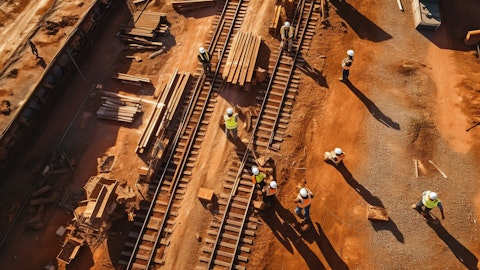Grupo Aeroportuario del Pacífico, S.A.B. de C.V. (NYSE:PAC) Q3 2025 Earnings Call Transcript October 22, 2025
Operator: Good morning, and welcome to GAP’s Third Quarter 2025 Conference Call. [Operator Instructions]. It is now my pleasure to turn the call over to GAP’s Investor Relations team. Please go ahead.
Maria Barona: Thank you, and welcome to GAP’s Third Quarter 2025 Conference Call. Prior to introducing GAP’s management team, I’d like to take a few moments to mention the forward-looking statements as described in the financial disclosure statements. Please be advised that any comments made today may not account for future economic circumstances, industry conditions, the company’s future performance or financial results. As such, any information discussed is based on several assumptions and factors that could change, causing actual events to materially differ from current expectations. For the complete note on forward-looking statements, please refer to the quarterly report. Thank you for your attention. Our speakers today from GAP are Mr. Raul Revuelta, Chief Executive Officer; and Mr. Saul Villarreal, Chief Financial Officer. At this time, I’ll turn the call over to Mr. Revuelta for his opening remarks.
Raul Musalem: Good morning, everyone, and thank you for joining us today. I am pleased to share with you the operational and financial highlights for the third quarter of 2025. Overall, and despite the passenger traffic slowdown in this quarter, this was another solid quarter for GAP, marked by continued revenue growth and profitability as well as important progress in terms of the company’s investment program and financial strategy. Let me start with the passenger traffic. During the quarter, international passenger traffic declined, mainly due to the immigration-related challenge and a more restrictive perception under the current U.S. administration, which has affected behavior of VFR and leisure passengers. In addition, the ongoing Pratt & Whitney engine issues continue to limit Volaris and Viva Aerobus seat capacity recovery, as carriers have indicated they expect to fully recover their fleet by 2027.
Despite this challenge, total passenger traffic across GAP’s 14 airports increased by 2.5% compared to the same period of 2024, reaching a total of 15.8 million passengers in the quarter. This growth was supported by new routes and additional frequencies, which helped offset the decline in international traffic and reflect the sustained recovery in domestic demand. Looking ahead, our strategy remains focused on connectivity and diversifying our network. During the fourth quarter, 8 new international routes to Canada will be launched, 3 from Guadalajara, 3 from Puerto Vallarta and 2 from Montego Bay, which will enhance passenger traffic and support demand during the high winter season. Furthermore, for the first time in the history of Los Cabos, it will be connected directly to Panama, expanding our network into Central America and thereby strengthening GAP position as a regional hub.
Turning to total revenues. This increased by 17.4% versus third quarter ’24, driven by the solid performance of both the aeronautical and non-aeronautical business. Aeronautical revenue grew by 18.3%, reflecting the new maximum tariff. The original plan was to implement the increase approval in 2 phases, 15% in March of ’25 and the remainder during 2026. However, after reviewing traffic performance and load factors trend during the year, we move forward with the second adjustment on an average of 7.5% starting September 1. Non-aeronautical revenues increased by 15.6%, both by the strong performance in both Mexico and Jamaica. Revenue from business operated directly by GAP rose by 30.1% increase mainly due to the consolidation of the cargo and bonded warehouse business, which contributed with MXN 559 million.

Revenues from third-party operators increased by 4.7% and include the opening of new commercial spaces and the renegotiation of contracts under better market conditions. It is worth noting that the strongest performing business lines were food and beverage, retail, duty-free, ground transportation and timeshares. Beyond the quarter results, non-aeronautical revenues continue to drive diversification and resilience in our business model. The expansion of commercial areas and the integration of the new services such as cargo operation strengthens GAP long-term revenue base. Looking ahead, we expect to continue optimizing our commercial offering and leveraging passenger flow growth to enhance value creation across all the airports. Moving on to the cost.
The cost of services increased by 14.1% compared to the same period last year. This increase reflects the impact of operation of jet bridges and airport buses, a task that was previously managed by third parties, but must now be operated directly by GAP due to the change in regulations. Without this cost, cost of services would have increased by around 4.8%. Despite this increase, our focus on strict cost discipline remains a priority. Our goal is to maximize operational efficiency and long-term sustainability, while ensuring that service quality and safety standards across our airports remain among the highest in the region. Turning now to profitability. EBITDA grew by 12.8%, reaching MXN 5.1 billion with an EBITDA margin of 64.3%, excluding IFRIC-12.
Margin was lower than in 2024, reflecting mainly the impact of the change in concession fees for our Mexican airports from 5% to 9%, which was payable signed 2024, but reflected in our P&L in 2025. Regarding our financial position, we remain in a strong liquidity position with MXN 11.7 billion in cash and cash equivalents as on September 30. In the third quarter ’25, we paid the second and final dividend installment of MXN 8.42 per outstanding share, which was approved at the Annual General Ordinary Shareholders’ Meeting. During the quarter, we successfully issued 2 new bond certifications under our long-term program for a total amount of MXN 8.5 billion. The proceeds are used to finance approximately MXN 7 billion in capital investment and to repay MXN 1.5 billion bank loans with Santander.
We also refinanced a USD 40 million credit line with Banamex, extending its maturity to 2030. Active management of our capital structure strength the balance sheet and provide us with the flexibility required to execute our long-term investment commitments and potential inorganic growth. In terms of CapEx, during the first 9 months of the year, we invest approximately MXN 7 billion. Most of these investments were related to the early stage of major infrastructure projects under the master development program, including terminal expansions, air site improvement, among others. Looking ahead, we remain cautiously optimistic. Macroeconomic uncertainty and exchange rate volatility may create a short-term challenge. However, it is important to highlight that GAP’s continue to benefit from a resilient domestic market, a diversified portfolio of airports and a disciplined financial management.
Furthermore, our strong financial position and continued growth in both aeronautical and non-aeronautical revenues allows GAPs to maintain its leadership position in the region and thus continue generating long-term value for our shareholders. Before closing, I would like to provide an update on our strategic expansion opportunities. The process related to Turks and Caicos tender remains ongoing. We submitted our bid last year and while evolution continue, no resolution has been announced yet. We are still analyzing the potential acquisition of Motiva Airports, including the information available in data room, review the transaction details and developing our financial model. As always, the market will be duly informed of any development, and we will be, as always, continue to focus on value creation.
Thank you again for your time, operator. Please open the line for questions.
Q&A Session
Follow Grupo Aeroportuario Del Pac Sab (NYSE:PAC)
Follow Grupo Aeroportuario Del Pac Sab (NYSE:PAC)
Receive real-time insider trading and news alerts
Operator: [Operator Instructions]. And we’ll take our first question from Rodolfo Ramos of Bradesco BBI.
Rodolfo Ramos: I have a couple, if I may. Can you talk a little bit about the traffic dynamics that you’re currently experiencing? I mean international traffic continues to underperform, especially in the VFR routes. You mentioned the immigration stance in the U.S. But yet when you see capacity deployment and the route development that, for example, Volaris is having, it’s targeting those very routes. So do you see a more pronounced recovery towards the end of the year in the next few months? And how do you feel about your guidance for the year? So that would be my first question. And I have a second one, if I may.
Raul Musalem: Thank you, Rodolfo. This is a Raul. I mean in general terms, we are suffering some deacceleration of VFR market mainly. We are seeing that deacceleration for sure directly routes from some of our airports to the U.S. as could happen in the Guanajuato – Chicago or Guadalajara – Sacramento, for instance, or — Los Angeles, for instance, but also in the routes that go through Tijuana and through the CBX to the U.S. In both of these markets, VFRs going directly to the U.S. and the VFR market going through Tijuana and through CBX to the U.S., we are seeing deacceleration that comes mainly for some kind of lack of information for the VFR market. Because if we think for a moment, all the passengers flying in a plane or [indiscernible] green car or they have like all the papers to be totally legal.
So the decrease on this market, in our view, will be something, I would say, that will be in place in the short term after the passengers in some way have a complete understand of the possible trends on the migrant policy of the U.S. administration. So what we are seeing is at least for the coming months, some decrease on the specific VFR markets. But we are seeing and we are optimistic about the coming years just when we review the seat capacity already announced by the different companies as Volaris. So saying that, we are still optimistic that the recovery of the VFR market will happen from the coming year.
Rodolfo Ramos: Okay. And just secondly, on the commercial side, the businesses that you operate are growing at a very rapid clip, which explains the strong performance that we saw in the non-aeronautical revenue per passenger. When you look at the — and maybe this is a broader question, but when you look at the different initiatives that you have in the pipeline, how far off are we from seeing this top line revenue growth stabilizing and growing more in line with the more traditional retail, food and beverage businesses?
Raul Musalem: It was a good question, Rodolfo. I mean, at the end of the day, we are seeing this double-digit growth in almost all our business lines directly operated by GAP. I mean we are really proud about all the efforts of our commercial area is doing to maximize the revenue to — I mean, play with the prices of the products and the tariffs and for sure, to manage the cost of these services. What we are seeing on the coming years is that some of these business lines will continue in a higher pace than the rest of the commercial business due to the fact that, for instance, there’s new commercial areas that we deploy in the coming 2 or 3 years as soon as we open a new terminal business — terminal areas. So for instance, as soon as we open the Puerto Vallarta new terminal building, we will see a jump on some of these specific business lines, but also as soon as we open the rest of the expansion of our terminal buildings in the coming years.
So in a general term, I would say that we will begin — or we will continue to see interesting rates or pace of growing on the directly operated business by GAP because we are seeing that we will continue expanding this business line on different airports and in different areas. I mean let’s, for instance, think for a second that our FBOs, today, we are just running Los Cabos and 3 months ago, we begin with La Paz. But for the next, I would say, 20 months, we will see the first FBO directly operated by GAP in Puerto Vallarta. The same will happen, for instance, with the hotels. We have a plan for a different development of hotels in the coming 5 years. It will give us other additional possibilities there. But in general terms, Rodolfo, I would say that the business directly operated by us, it will — at least in the coming 3 to 4 years, we will grow in a faster pace than the other business operated by third parties.
Operator: And our next question comes from Guilherme Mendes of JPMorgan.
Guilherme Mendes: The first one is a follow-up on costs. You mentioned in the beginning about the additional costs throughout the quarter. Just wondering if the level of cost and expenses that we saw in the third quarter can be assumed for the coming quarters, which according to our calculations would probably put you on the lower end of your guidance for — in terms of EBITDA margin for the year. Just wondering if the directional makes sense. And the second one, it’s on the MDP maximum tariffs. If you can share at what level you are as of the end of third quarter? And if the base case of increasing prices in early ’26 and potentially at some time in the second half of ’26, is it still the base case at this point?
Saúl García: Guilherme, this is Saul. Well, related to the cost, we believe that this would be in average, the level of costs that we will see in the following quarters is very important to understand that in the way we increase the facilities in the airports, we increase the headcount, security, cleaning, et cetera. So it is part of the business. So we will see this level in the following quarters.
Raul Musalem: In terms of the maximum tariff, I mean, first of all, talking about the EBITDA margins, as you remember, we present a guidance for the — at the beginning of the year, and we are still in our guidance related to the margins. And the other part related with the maximum tariff, let’s remember that in 1st of March, we have a 15% increase on passenger fees for all of our airports, domestic and international passengers. On September 1, we increased an additional 7.5% of increase. For the coming year, we are thinking that on the early February of coming year, we will increase again our tariff. So it will be important to have in mind that for 2026, we want to have in place the effect of 3 different moment of tariff. January and February, for instance, we have the effect of the 15% and the 7% increase.
From March to September, we have the effect of the increase of the 7.5% of the tariffs. And during almost all the year from February to December, we will have in place the increase of the additional tariff that we put in place on coming year. So in terms of tariff for the coming year, we will expect a much better fulfillment of the maximum tariff. And for sure, it will depend, for instance, of what happened with the inflation, the price equation and the second, what happened with the dollar and the exchange rate. So in general terms, I will say that we are still passing through all the changes on the passenger fleet to have the better possible fulfillment of maximum tariff. And we will see a coming year that will be — I would say that we will have an important increase on that specific line of the business.
Saúl García: And just to complement your — answering your question, Guilherme, related to the EBITDA margin, we will be very close to the guidance we really have to…
Operator: And our next question comes from Jens Spiess from Morgan Stanley.
Jens Spiess: Just on the Motiva airport assets, I know it probably is limited what you can comment, but still like hypothetically, are you planning to go for the — all of the assets or maybe do a partnership with some of the other potential bidders like Aena? And if you’re going alone for all the assets, would you be raising equity or mainly finance it via debt?
Raul Musalem: Thanks Jens. I mean we are still right now working on the different options. I would tell you that today, we are not fully decided which will be the way that we will find our bidding for this opportunity. We are opening for partnership or for going along, I mean, on these steps. But what is important is that we are, I mean, working as always in a really disciplined way to review the numbers, thinking what’s going to be accretive for our company. And for sure, in the case that we continue with this opportunity, we are thinking that all the money will come from leverage. So I mean, I would say that these are our main takes today on this specific opportunity of Motiva. We are still working, and we are open for different ways of participating that means alone or with some kind of partnership and all the money will come from leverage.
Operator: Our next question comes from Gabriel Himelfarb of Bank of Nova Scotia.
Gabriel Himelfarb Mustri: Just a quick follow-up question. Can you repeat the tariff increase that are expected for 2026? And if you are already — or when you expect to reach the 100% maximum tariff?
Raul Musalem: For the coming years, we are still working on which is going to be the increases. I mean, it’s under way because we need to work on all the procedure with the AFAC, with the federal agency. So we are just on that, but we are expecting that it will happen on February. The other part is with all the change that we are expecting for 2026 will be, I mean, depending for sure in inflation and exchange rate, we’re going to be around between 93% to 97% of fulfillment of the tariff, I mean, at the end of the ’26. And that are mainly the main probs in terms of tariffs.
Gabriel Himelfarb Mustri: So it’s 95% at the end of 2026, right, what you’re expecting?
Raul Musalem: Yes, in the range of that number.
Operator: [Operator Instructions]. And our next question comes from Jorge Vargas of GBM.
Jorge Vargas Cuadra: Regarding the potential acquisition of Motiva’s airport portfolio in Brazil, could you share any color on the expected time line along with the estimated investment size and the main strategic rationale behind your interest? And additionally, could you provide some context on how Brazil’s concession structure works and how it differs from the Mexican model?
Raul Musalem: Thanks, Jorge. I mean, for sure, the rationale is diversification among our main business has been airports. As you know, the airports industry opportunities are little [ small ] ones per year around the world. So for sure, as airport operator always would be interesting for us to analyze any of these opportunities. Motiva is a group of airports that have different concessions, different countries and different, I would say, frameworks of concession frameworks. We are going in a really quick way. We have a big 4 groups of airports in Brazil with different — each one of them with different rules of concession. Also, it is in the PAC — Quito Airport. Also San Jose Costa Rica Airport and [indiscernible] Airports.
What we are seeing in all of this for GAP is we will have a potential opportunity to increase the value of those companies through 2 different ways. The first related with commercial revenues, applying our well-known model of increase the commercial revenues. And the second, it was related with the discipline of the cost. We think both of these will be an interesting area to explore to bring all the experience of GAP on this air. But again, we are really in, I would say, final analyzing of this opportunity. Today, we will have a complete view if we will participate in the last, the last part of this bidding process. So we are continuing analyzing. Related with the time line, I would say that this is, I would say, a structure and a project that the time line is rolling directly by Motiva.
We are expecting that on the mid of November, could happen the presentation of the final numbers. But again, it will depend completely on the seller because if we see this process has all the past had different moments and changes of the time line. At least for the case of GAP, we are seeing that for the mid of November, we will make our final decision related with this transaction.
Operator: [Operator Instructions]. And we have a question from Edson Murguia from SummaCap.
Edson Murguia: I have 2 of them. I was wondering if you can give us more color about these new routes from Los Cabos. Even looking forward, there is a possibility that other airlines can connect between Los Cabos or maybe Puerto Vallarta to Central America or the ports of or even South America. Could you give us — I don’t know if it’s possible to give us the name of the airline who we operated Los Cabos to Panama? And the second question is regarding to the cargo and bonded warehouse. I was wondering if you have similar initiatives or initiatives related to new buildings or even with the master development plan looking ahead, similar to the food and beverage and new terminal buildings and so on because it seems that cargo and bonded warehouse is on a good growth pace for the following quarters.
Raul Musalem: In the case of the route for Los Cabos, I mean, it is important. It’s really interesting to see for the first time a direct operation in South America. As you perfectly know, all the Panama hub is a great opportunity to capture all the traffic going beyond, I mean, that connect to the rest of South America and Central America. So I think it’s a great opportunity for Los Cabos. At the end of the day, it’s opening a complete new market and a completely new way of opportunities around that. For the case of Puerto Vallarta, for the last, I would say, almost at least 9 years, Puerto Vallarta is connected directly to Panama with Copa. We have — I mean, after the COVID, we have a close of the services and coming back with a less number of frequencies just in some seasons.
But at the end of the day, what we know about the direct connections with Panama is that we — the hub of Panama opens the opportunity for a broader market related with all the [indiscernible] in South America. So in that terms, I think that, yes, it’s a great opportunity for Cabos to meet a completely new market to that destination.
Saúl García: Edson, this is Saul. Related with your second question. The cargo bonded warehouse is not a business regulated under the master development program. So it is nothing to do with our new terminal for passengers, but we are interested to replicate this business in other airports if it is possible and according to demand and the opportunity of market in those airports. So it is a great business. It was a great acquisition. We will be following some opportunities in the future in other airports.
Maria Barona: Well, we have some questions from the webcast. There is 2 from Rafael Simonetti from UBS. One of them was already explained. So the only one that we have, it is aeronautical tariff declined quarter-over-quarter. Could you elaborate on the main drivers behind this decrease?
Saúl García: Rafael, this is Saul. Yes, it was due to the component and the mix of passenger traffic we have in our airports. International traffic declined and those airports have the highest passenger charges. Therefore, this affects directly to the revenue and also the exchange rate, which the peso appreciated in this quarter around 4.6%. Therefore, that the passenger — aeronautical revenue per passenger declined slightly.
Maria Barona: Thank you, Saul. And well, we have another question from [ Daniela Gutman from OSMO ]. And the question is, what is the expected effect of next year World Cup in traffic figures?
Raul Musalem: I mean it’s hard to know because at the moment, we have like different scenarios related with what could be the impact on the World Cup in specifically in Guadalajara and some different other airports. We are thinking that for sure, Guadalajara with the 4 games will have a positive effect. And Tijuana that will be through the CBS will be connected to some of the games in South California. In Southern California, we think also that could have some positive effect. Today, it’s really difficult to understand how big could be the effect of that and will depend of the lottery related with the different selection that will be on Guadalajara for the World Cup. So at the beginning of the coming year, it will be this lottery of national teams, and we will know which is going to be the matches that will happen in Guadalajara.
And in that moment, we could have a more clear way to prepare some scenarios of possible increase on traffic. I mean the numbers that, for instance, the FIFA and the government has announced is that could be from the case of Guadalajara, something that goes from 300,000 to 0.5 million passengers that could come to the city. But it’s really — for the moment, it’s unclear until we know which national teams will be allocated in Guadalajara.
Maria Barona: Well, thank you, Raul. We have another one in the webcast from Enrique Sojo from Fundamenta. He’s asking, could you provide even further details on the commercial areas, which will come online in the next few years? And do you have any longer-term vision for what level of non-aeronautical revenue per pax may reach?
Raul Musalem: Okay. I mean, as you remember, we have touched on that, we will be — for 2029, our terminal buildings gap in Mexico will increase around 55% in terms of the square meters. So for sure, we will have a great opportunity to deploy additional commercial offer on those new terminal buildings and expansion of terminal buildings. The biggest one will come from 3 different airports. I mean, 4 different airports will have opportunities for increase the commercial business in terms of really interesting numbers. The first one is the Terminal 2 of Guadalajara that will be operated for 2029 or beginning of 2029. The next one is Puerto Vallarta that will be a second terminal building that will open for January or the first quarter of ’27.
The third one is the expansion of the Tijuana Airport that will be ready for begin operation in ’28. And the last one is the expansion of the Terminal 2 building of Los Cabos that will be on operation for ’27 mainly. In that sense, we will have a great amount of opportunities to expand commercial business. So yes, for the end of the year, the master plan, we will have this — like the big number, this expansion that we will see of 55% of increase in square meters in our terminal building. And in that way, we will have that reflection on opportunities to increase our commercial spaces in our terminals.
Operator: And we have a question from Alan Macias of Bank of America.
Alan Macias: Just a question on international traffic. If you can just go through the 4 main airports and especially Puerto Vallarta has been quite weak year-to-date. Just if you can go through the negative impacts for international traffic.
Raul Musalem: I will say that in these I would say the first 9 months, we are seeing a decrease on passengers, mainly on international for Puerto Vallarta. The good news there is that we are seeing a much better winter. We are reviewing the number of seats coming from mainly Canadian markets and some other different international or U.S. routes that are coming back with additional seats for the winter season on this year that will give us a much better first quarter of the coming year in Puerto Vallarta. But on the first 9 months, what we are seeing is a decrease of passengers mainly due to a decrease of capacity for American Airlines, mainly in the case of of Puerto Vallarta with some other effect coming from [ Spirit. ] But in general terms, what we’re seeing in Vallarta is a decrease on passengers, as you say, of 5% on this year on international market.
But we are optimistic about the coming year because we are seeing the coming back of some of these seats on this winter season. And the additional, I would say, increase on passengers from Canadian capacity were also a great news for Puerto Vallarta…
Operator: And it appears that we have no further questions at this time. I will now turn the program back to our presenters for closing remarks.
Raul Musalem: Thank you once again for joining us today. Please contact our Investor Relations team with any additional questions you may have. Have a great day, and thank you for your attention.
Operator: Thank you. This does conclude GAP’s conference call. Thank you for your participation. You may disconnect at any time.
Follow Grupo Aeroportuario Del Pac Sab (NYSE:PAC)
Follow Grupo Aeroportuario Del Pac Sab (NYSE:PAC)
Receive real-time insider trading and news alerts




